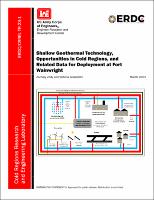Please use this identifier to cite or link to this item:
https://hdl.handle.net/11681/46672Full metadata record
| DC Field | Value | Language |
|---|---|---|
| dc.contributor.author | Zody, Zachary J. | - |
| dc.contributor.author | Gisladottir, Viktoria R. | - |
| dc.creator | Cold Regions Research and Engineering Laboratory (U.S.) | - |
| dc.date.accessioned | 2023-03-24T13:27:40Z | - |
| dc.date.available | 2023-03-24T13:27:40Z | - |
| dc.date.issued | 2023-03 | - |
| dc.identifier.govdoc | ERDC/CRREL TR-23-1 | - |
| dc.identifier.uri | https://hdl.handle.net/11681/46672 | - |
| dc.identifier.uri | http://dx.doi.org/10.21079/11681/46672 | - |
| dc.description | Technical Report | en_US |
| dc.description.abstract | The DoD considers improving Arctic capabilities critical (DoD 2019; HQDA 2021). Deployment of shallow geothermal energy systems at cold regions installations provides opportunity to increase thermal energy resilience by lessening dependence on fuel supply and supporting installations’ NetZero transitions. Deployment can be leveraged across facilities, for ex-ample using Fort Wainwright metrics for implementation of geothermal in cold region bases. Fort Wainwright is an extreme case of heating dominant loads owing to harsh conditions in Alaska, making it ideal for proving feasibility in most heating dominant installations. Proven feasibility and potential mass deployment will help reduce emissions and increase resilience across the DoD cold region network. This report introduces the shallow geothermal energy and storage technology combination that would best fit demonstration in Alaska. Focus is on leveraging shallow, low-temperature geothermal for the development of a larger geothermal district heating and cooling (GDHC) system with underground thermal energy storage (UTES) and geothermal heat exchangers (GHX). Such systems are proven in cooling dominant climates, and individual components are proven in heating dominant climates, but deployment of a larger system in a heating dominant climate is not well established. Deployment at Fort Wainwright would represent an improvement in the technology. | en_US |
| dc.description.sponsorship | United States. Army. Corps of Engineers. | en_US |
| dc.description.tableofcontents | Abstract ................................................................................................................................................... ii Figures and Tables ................................................................................................................................. iv Preface ..................................................................................................................................................... v 1 Introduction ..................................................................................................................................... 1 1.1 Background ..................................................................................................................... 1 1.2 Objectives ........................................................................................................................ 1 1.3 Approach ......................................................................................................................... 1 2 Shallow Geothermal and Cold Regions Opportunity .................................................................. 2 2.1 Cold regions opportunity ................................................................................................ 3 2.2 Geothermal in cold regions ............................................................................................ 5 2.3 Shallow geothermal systems ......................................................................................... 6 3 Preliminary Data Screening for Fort Wainwright Area ............................................................ 14 3.1 Geology and hydrology ................................................................................................. 14 3.2 Geophysical surveys and tests ..................................................................................... 21 4 Summary ....................................................................................................................................... 23 Bibliography .......................................................................................................................................... 24 Appendix: Referenced Data ................................................................................................................ 30 Abbreviations ........................................................................................................................................ 38 Report Documentation Page (SF 298) .............................................................................................. 39 | - |
| dc.format.extent | 47 pages / 1.3 MB | - |
| dc.format.medium | - | |
| dc.language.iso | en_US | en_US |
| dc.publisher | Engineer Research and Development Center (U.S.) | en_US |
| dc.relation.ispartofseries | Technical Report (Engineer Research and Development Center (U.S.)) ; no. ERDC/CRREL TR-23-1 | - |
| dc.rights | Approved for Public Release; Distribution is Unlimited | - |
| dc.source | This Digital Resource was created in Microsoft Word and Adobe Acrobat | - |
| dc.subject | Alaska energy | en_US |
| dc.subject | Cold regions energy | en_US |
| dc.subject | Geothermal district heating and cooling | en_US |
| dc.subject | Shallow geothermal | en_US |
| dc.subject | Thermal resilience | en_US |
| dc.subject | Underground thermal energy storage | en_US |
| dc.title | Shallow geothermal technology, opportunities in cold regions, and related data for deployment at Fort Wainwright | en_US |
| dc.type | Report | en_US |
| Appears in Collections: | Technical Report | |
Files in This Item:
| File | Description | Size | Format | |
|---|---|---|---|---|
| ERDC-CRREL TR-23-1.pdf | 1.3 MB | Adobe PDF |  View/Open |